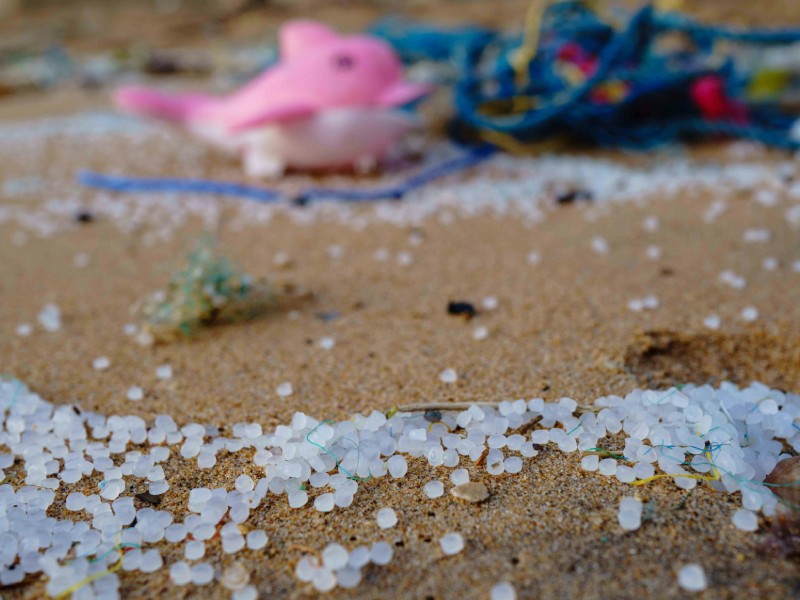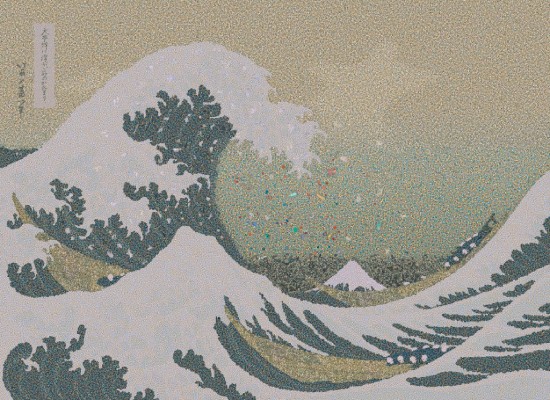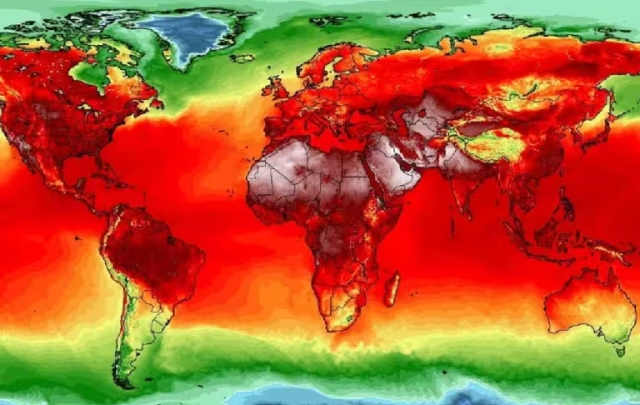
Ed. note: This excerpt is taken from Pages 54 – 60. Chapter 2 of A Poison Like No Other, by Matt Simon, published by Island Press, and posted here with permission.
Every day, ocean life embarks on a mass migration that puts a bird flock or reindeer herd to shame. When the sun’s up, animals large and small hang out in the relative safety of deeper, darker waters, where their predators can’t see them. But at night, they move en masse to surface waters, where there’s more sustenance—and more microplastics they mistake for sustenance. The extreme diversity of microplastics, all shapes and sizes and colors, provides a diversity of different-looking “food” for different foragers with different diets.46 Indeed, a 2009 expedition in the Pacific Ocean collected fishes and found microplastic in the stomachs (they didn’t look in the rest of the digestive system) of 4.8 percent of species that don’t do this kind of vertical migration, as it’s known, while 11.6 percent of migrating species tested positive for plastic.47 This suggests that the migrants are picking up more particles closer to the surface when they feed, whereas the non-migrating fishes feed exclusively in depths, where there may be fewer microplastics. All told, these researchers calculated that in the gyre that forms the Great Pacific Garbage Patch, fishes consume up to 53 million pounds of plastic debris each year just in the mesopelagic zone, between 650 and 3,300 feet deep. Migratory species are therefore acting as vehicles to disperse microplastics farther down the water column: when they return to the darkness of the depths and poop, out come the particles. The fecal matter and microplastics join all the other organic debris from giant larvacean houses and decaying organisms to make marine snow, which falls to the seafloor and accumulates as sediment.
So even in the deepest depths, ocean life is feeding on microplastics. Between 2008 and 2017, oceanographers visited nine sites, ranging from 23,000 feet to 36,000 feet at the Challenger Deep in the Mariana Trench (the deepest point in the ocean), and collected amphipods, crustaceans that look like shrimp.48 At every site, at least half of the animals had microplastic in their guts. The Mariana Trench’s amphipods had all ingested microplastic, and they tallied the highest average particle count per individual among the nine sites. The vast majority of these particles were fibers. A separate expedition found up to 2,200 microplastics per liter of sediment from the Mariana Trench, so it’s no wonder the animals down there are so contaminated.49
In another survey in the middle of the Atlantic, three-quarters of captured deep-sea fishes had microplastics in their bellies.50 One specimen of a common fangtooth had two prey in its stomach, a cock-eyed squid and a bearded sea devil, which themselves had microplastics in their guts. (As a general but informal rule, scientists tend to give deep-sea animals names that are at once fantastical and perfectly descriptive. The fangtooth has a mouth full of giant teeth, one of the cock-eyed squid’s peepers is enlarged to collect faint light from above, and the bearded sea devil grows frilly bioluminescent structures on its chin.) This reveals a dynamic called trophic transfer: a small species eats microplastic, then a predator eats that small species, and a still larger predator eats that predator51—a perpetual biological cycling of microplastics. If you were to somehow instantly remove all the particles from ocean waters and sediments, they’d live on by transferring from gut to gut. Everything eats, everything gets eaten, and microplastics go along for the ride.
Microplastics aren’t just in the food chain—they’ve penetrated the very base of the food chain. Surface waters teem with little organisms collectively known as plankton, which are divided into two groups. We’ve got bacteria and algae known as phytoplankton, which harvest their energy from the sun. Though individual phytoplankton are microscopic, great blooms of them create green clouds that drift along the surface of the world’s oceans. Like plants do on land, these photosynthetic organisms take in the carbon dioxide dissolved in seawater and spit out oxygen, and a whole lot of it: they’re responsible for two-thirds of the atmosphere’s oxygen content.52 The carbon the organisms absorb goes the other way, sinking to the seafloor when the phytoplankton die. These life forms, then, are critical actors in the carbon cycle, sequestering CO2 and locking it in the ocean depths.
They’re also a critical source of food for the other group of plankton: zooplankton. These include tiny species of animals like crustaceans and jellyfish and marine worms. To reproduce in the open ocean, a female fish releases masses of eggs and a male releases sperm, which all drift around in planktonic clouds. When those eggs hatch into larval fish, they become more active participants in the community, eating phytoplankton and each other. They are, in turn, eaten by bigger fish and seabirds.
Now you can add microplastic as a third player to the vast planktonic universe sparkling across Earth’s oceans. Scientists have analyzed a trove of stashed-away plankton samples, collected off the coast of Scotland since the 1960s, and found a significant rise in microfiber contamination over the decades—a sad echo of Jennifer Brandon’s sediment samples.53 Others have taken water samples off Antarctica and found zooplankton tangled up in microfibers.54 Biologists not only find petroplankton and biological plankton mingling together in water samples taken from different depths but also find the particles mingling in the stomachs of captured zooplankton: baby salmon that (eventually) feed bears and humans, the crustaceans that feed fish and birds, the krill that feed whales.55 A survey in the South China Sea tested fish larvae, jellyfish, shrimp, and predatory worms and found microplastics in them all.56 Adult fish that feed on zooplankton, or on smaller fish that feed on zooplankton, then assume the particles: a sampling in the remote South Pacific turned up microplastics in 97 percent of fish species, including mahi-mahi, red snapper, and barracuda57—one foot-long Pacific chub was burdened with 104 pieces of plastic in its gut. It’s worth noting that the most contaminated fish were in the most remote waters, around Easter Island, where the South Pacific Gyre—the counterpart of the North Pacific Gyre, which creates the Great Pacific Garbage Patch—accumulates plastic.
Troubled Waters: How Microplastics Are Impacting Our Oceans and Our Health
Join Dr. Britta Baechler (Ocean Conservancy), Christy Leavitt (Oceana), Emily Penn (ocean advocate & skipper), and Madeline Kaufman (Debris Free Oceans) on an exploration of this topic and what we can do in response.
Any size and shape and color of microplastic you can dream of, it’s out there, so a speck too big for one hunter becomes easy pickings for the next. Nurdles, which look just like nutritious fish eggs, may be particularly tempting. Not many marine animals are big enough to choke on a whole plastic bag, but a great many diminutive creatures can choke on microplastic they mistake for prey: lab experiments have shown that some zooplankton prefer eating aged plastics over pristine plastics by a wide margin.58 These animals may be sniffing out the microbes they typically eat, only to instead ingest petroplankton with microbial frosting. The plastisphere, as scientists Erik Zettler and Linda Amaral-Zettler are calling it, is a new kind of microbial habitat on Earth. Moving from surface waters to deep waters and back again, from the Atlantic to the Arctic, from coral reefs to open ocean, microplastics gather miniature communities like stamps on a passport.59 “Basically it’s a mini-world,” says Linda. “There are organisms that make their own food, that photosynthesize. There are predators there. There are prey. There are symbionts and there are pathogens as well—or at least as we know them to be pathogens on animals, and potentially humans as well.” Under a microscope, this mini-world bustles.60 Wispy filaments, possibly produced by bacteria, wrap around kayak-shaped photosynthetic organisms known as diatoms.61 A single-celled organism called a ciliate grows like a mushroom from the surface. Keep zooming in and you’ll see it’s got company: the unmistakable tubular forms of bacteria cover its bulb but—more curious still—not its stalk.
Far from being a sanitary piece of synthetic material, each microplastic crawls with life. “It’s this three-dimensional structure that provides all kinds of different niches for primary producers, consumers, degraders, parasites, predators, grazers—you name it,” says Erik. Bacteria and viruses mingle with animals, like the larvae of barnacles. “Each of those animals has its own microbiome of additional microbes that are brought to this. So it really becomes quite a complicated little community.”62 As these microplastics tumble around the sea, they fragment—some organisms will hold on, others won’t. Microbes may themselves break down the plastic: Linda and Erik have found spherical cells resting in pits on a microplastic’s surface, suggesting that whatever species this is, it could be digesting the polymer. “At some point,” Erik says, “when you get down to the nanoplastics range, it’s not going to be the microbe sticking to the plastic, it’s going to start becoming the plastic sticking to the microbes.” Erik and Linda have only begun to understand this world. They can test the DNA on microplastics to reveal what kinds of bacteria are present, but that can’t tell them how those players are interacting with one another. The bacteria Vibrio, for example, has dominated many of their samples, and other researchers have found the microbe hitching rides on microplastics elsewhere, from the Baltic Sea to the coasts of China and Brazil.63 This is the bug in undercooked seafood that can cause severe gastrointestinal distress, but Erik and Linda caution that just because Vibrio is there, often in significant quantities, doesn’t necessarily mean it’s a threat to the health of sea creatures or humans. What’s clear, though, is that ocean life has never encountered anything quite like the plastisphere.
Consider the journey of a polyester microfiber. During its life on your sweater, it’ll have gathered microbes from your skin and the air around you. Flushed to a wastewater treatment facility, the fiber is soaked in human waste, acquiring new microbes there.64 In a river, the plastisphere steeps in agricultural runoff rich in nutrients, which opportunistic microbes might thrive on.65 Finally in the open ocean, the particle encounters a still more alien saltwater microbiome—bacteria, viruses, animal larvae. Floating at the surface, it attracts sunlight-loving organisms,66 but then grows so heavy with life that it starts sinking.67 In the darkness, the microbes dependent on light will perish, happily replaced by others in the new habitat.68 As currents carry it dozens and hundreds and thousands of miles, our fiber will sample innumerable unique oceanic microbiomes, its own microbiomes reshuffling all the while.69 It may even act as a shuttle to introduce microbes to new oceanic habitats.
And then, disaster—mass extinction in the plastisphere. A baby crustacean hoovers up the microplastic and its hangers-on, which are now imprisoned in a hostile habitat meant to digest things. Much microbial death later, the fiber comes out the other end. “There may be a few really hardy survivors that are still left on basically pristine plastic, and it gets put out into the ocean with a little dollop of fertilizer as well,” Erik Zettler says. “So all of a sudden you have this yummy piece of pristine surface with high nutrient concentration available to a whole new community. That might be very different from the community that formed when that plastic first went into the ocean.”
Zooplankton that feed on algae could instead be filling up their bellies with microplastics coated in algae, leading to the growth of the algal blooms they normally keep in check. When these blooms die, they suck oxygen out of the water, killing off fish and other life in the area. Microplastics—with their own chemicals and agglomerated pollutants— might also directly influence the proliferation of phytoplankton.70 Some studies have shown that particles inhibit the growth of the tiny algae while others have shown the opposite, though these experiments were done with high concentrations of microplastics in the lab, where conditions are different than out at sea. (This is a common practice in science, generally speaking: researchers do it to elicit responses from organisms, unrealistic as the concentrations may be.71) But with ever more petroplankton flowing into the ocean and persisting because plastic is durable by design, microplastic concentrations will be 50 times what they are now by 2100, according to one estimate.72 “The modeling predictions are suggesting that within the next 50 to 100 years, if we carry on with business as usual, then those concentrations in the environment will reach the same kinds of concentrations as we’re seeing in laboratory experiments,” says University of Plymouth marine biologist Richard Thompson, who coined the term microplastic. “Then we’ll start to see quite widespread ecological harm if we don’t start to change our ways.” The ripple effects could be profound.73 If microplastics encourage the growth of phytoplankton, they’d encourage the algae’s sequestration of carbon from the atmosphere and the release of oxygen. Great for the animals on the land that breathe oxygen, but not great for fish when local water oxygen levels drop as phytoplankton die. Or instead microplastics could be discouraging the growth of phytoplankton, having the opposite effect on the cycle of carbon and oxygen in addition to shrinking a critical food source for zooplankton. (The seas have in no small part helped save humanity from itself, sequestering a third of the carbon we’ve pumped into the atmosphere, so these are vital processes we’re talking about.74) It might also be that the particles are somehow decreasing the photosynthetic efficiency of the algae, as several lab studies have suggested. Basically, scientists know that phytoplankton and petroplankton are in constant contact out there, but they don’t yet know how they’re interacting. The planktonic party, though, is growing increasingly crowded with microplastics—that much is for sure.
- Davison, Peter, and Rebecca G. Asch. 2011. “Plastic Ingestion by Mesopelagic Fishes in the North Pacific Subtropical Gyre.” Marine Ecology Progress Series 432:173–80. https://doi.org/10.3354/meps09142.
- Jamieson, Alan J., Lauren Brooks, William D. K. Reid, Stuart B. Pierntey, and Bhavani E. Narayanaswamy. 2019. “Microplastics and Synthetic Particles Ingested by Deep-Sea Amphipods in Six of the Deepest Marine Ecosystems on Earth.” Royal Society Open Science 6 (2): 1–11. https://doi.org/10.1098/rsos.180667.
- Peng, Xiaotong, M. Chen, Shun Chen, Shamik Dasgupta, Hengchao Xu, Kaiwen Ta, Mengran Du, et al. 2018. “Microplastics Contaminate the Deepest Part of the World’s Ocean.” Geochemical Perspectives Letters 9:1–5. https://doi.org/10.7185/geochemlet.1829.
- McGoran, Alexandra R., James S. Maclaine, Paul F. Clark, and David Morritt. 2021. “Synthetic and Semi-Synthetic Microplastic Ingestion by Mesopelagic Fishes from Tristan da Cunha and St Helena, South Atlantic.” Frontiers in Marine Science 8:78. https://doi.org/10.3389/fmars.2021.633478.
- Miller, Michaela E., Mark Hamann, and Frederieke J. Kroon. 2020.“Bioaccumulation and Biomagnification of Microplastics in Marine Organisms: A Review and Meta-Analysis of Current Data.” PLoS ONE 15 (10): e0240792. https://doi.org/10.1371/journal.pone.0240792.
- University of Leicester. 2015. “Failing Phytoplankton, Failing Oxygen: Global Warming Disaster Could Suffocate Life on Planet Earth.” ScienceDaily. https://www.sciencedaily.com/releases/2015/12/151201094120.htm.
- Thompson, Richard C., Ylva Olsen, Richard P. Mitchell, Anthony Davis, Steven J. Rowland, Anthony W. G. John, Daniel McGonigle, and Andrea E. Russell. 2004. “Lost at Sea: Where Is All the Plastic?” Science 304 (5672): 838. https://doi.org/10.1126/science.1094559.
- Absher, Theresinha Monteiro, Silvio Luiz Ferreira, Yargos Kern, Augusto Luiz Ferreira Jr., Susete Wambier Christo, and Rômulo Augusto Ando. 2019. “Incidence and Identification of Microfibers in Ocean Waters in Admiralty Bay, Antarctica.” Environmental Science and Pollution Research 26:292–98. https://doi.org/10.1007/s11356-018-3509-6.
- Lin, Vivian S. 2016. “Research Highlights: Impacts of Microplastics on Plankton.” Environmental Science: Processes and Impacts 18:160–63. https://doi.org/10.1039/C6EM90004F; Desforges, Jean-Pierre W., Moira Galbraith, and Peter Ross. “Ingestion of Microplastics by Zooplankton in the Northeast Pacific Ocean.” Archives of Environmental Contamination and Toxicology 69:320–30. https://doi.org/10.1007/s00244-015-0172-5.
- Sun, Xiaoxia, Qingjie Li, Mingliang Zhu, Junhua Liang, Shan Zheng, and Yongfang Zhao. 2017. “Ingestion of Microplastics by Natural Zooplankton Groups in the Northern South China Sea.” Marine Pollution Bulletin 115 (1–2): 217–24. https://doi.org/10.1016/j.marpolbul.2016.12.004.
- Markic, Ana, Clarisse Niemand, James H. Bridson, Nabila Mazouni- Gaertner, Jean-Claude Gaertner, Marcus Eriksen, and Melissa Bowen. 2018. “Double Trouble in the South Pacific Subtropical Gyre: Increased Plastic Ingestion by Fish in the Oceanic Accumulation Zone.” Marine Pollution Bulletin 136:547–64. https://doi.org/10.1016/j.marpolbul.2018.09.031.
- Botterell, Zara L. R., Nicola Beaumont, Matthew Cole, Frances E. Hopkins, Michael Steinke, Richard C. Thompson, and Penelope K. Lindeque. 2020. “Bioavailability of Microplastics to Marine Zooplankton: Effect of Shape and Infochemicals.” Environmental Science and Technology 54 (19): 12024–33. https://doi.org/10.1021/acs.est.0c02715.
- Yang, Yuyi, Wenzhi Liu, Zulin Zhang, Hans-Peter Grossart, and Geoffrey Michael Gadd. 2020. “Microplastics Provide New Microbial Niches in Aquatic Environments.” Applied Microbiology and Biotechnology 104:6501–11. https://doi.org/10.1007/s00253-020-10704-x.
- Zettler, Erik R., Tracy J. Mincer, and Linda A. Amaral-Zettler. 2013. “Life in the ‘Plastisphere’: Microbial Communities on Plastic Marine Debris.” Environmental Science and Technology 47 (13): 7137–46. https://doi.org/10.1021/es401288x.
- Amaral-Zettler, Linda A., Erik R. Zettler, Tracy J. Mincer, Michiel A. Klaassen, and Scott M. Gallager. 2021. “Biofouling Impacts on Polyethylene Density and Sinking in Coastal Waters: A Macro/Micro Tipping Point?” Water Research 201:117289. https://doi.org/10.1016/j.watres.2021.117289.
- Amaral-Zettler, Linda A., Erik R. Zettler, and Tracy J. Mincer. 2020. “Ecology of the Plastisphere.” Nature Reviews Microbiology 18:139–51. https://doi.org/10.1038/s41579-019-0308-0.
- Bowley, Jake, Craig Baker-Austin, Adam Porter, Rachel Hartnell, and Ceri Lewis. 2021. “Oceanic Hitchhikers: Assessing Pathogen Risks from Marine Microplastic.” Trends in Microbiology 29 (2): 107–16. https://doi.org/10.1016/j.tim.2020.06.011.
- Amaral-Zettler, Linda A., Tosca Ballerini, Erik R. Zettler, Alejandro Abdala Asbuna, Alvaro Adamee, Raffaella Casotti, Bruno Dumontet, et al. 2021. “Diversity and Predicted Inter- and Intra-Domain Interactions in the Mediterranean Plastisphere.” Environmental Pollution 286:117439. https://doi.org/10.1016/j.envpol.2021.117439.
- Harrison, Jesse P., Timothy J. Hoellein, Melanie Sapp, Alexander S. Tagg, Yon Ju-Nam, and Jesús J. Ojeda. 2018. “Microplastic-Associated Biofilms: A Comparison of Freshwater and Marine Environments.” In Freshwater Microplastics: Emerging Environmental Contaminants? The Handbook of Environmental Chemistry 58, edited by Martin Wagner and Scott Lambert. https://doi.org/10.1007/978-3-319-61615-5_11.
- Kooi, Merel, Egbert H. van Nes, Marten Scheffer, and Albert A. Koelmans. 2017. “Ups and Downs in the Ocean: Effects of Biofouling on Vertical Transport of Microplastics.” Environmental Science and Technology 51 (14). https://doi.org/10.1021/acs.est.6b04702.
- Kaiser, David, Nicole Kowalski, and Joanna J. Waniek. 2017. “Effects of Biofouling on the Sinking Behavior of Microplastics.” Environmental Research Letters 12 (12). http://dx.doi.org/10.1088/1748-9326/aa8e8b.
- Coyle, Roisin, Gary Hardiman, and Kieran O’ Driscoll. 2020. “Microplastics in the Marine Environment: A Review of Their Sources, Distribution Processes, Uptake and Exchange in Ecosystems.” Case Studies in Chemical and Environmental Engineering 2:100010. https://doi.org/10.1016/j.cscee.2020.100010.
- Amaral-Zettler, Linda A., Erik R. Zettler, Beth Slikas, Gregory D. Boyd, Donald W. Melvin, Clare E. Morrall, Giora Proskurowski, and Tracy J. Mincer. 2015. “The Biogeography of the Plastisphere: Implications for Policy.” Frontiers in Ecology and the Environment 13:541–46. https://doi.org/10.1890/150017.
- Nava, Veronica, and Barbara Leoni. 2021. “A Critical Review of Interactions between Microplastics, Microalgae and Aquatic Ecosystem Function.” Water Research 188:116476. https://doi.org/10.1016/j.watres.2020.116476.
- Prata, Joana C., Joao P. da Costa, Isabel Lopes, Anthony L. Andrady, Armando C. Duarte, and Teresa Rocha-Santos. 2021. “A One Health Perspective of the Impacts of Microplastics on Animal, Human and Environmental Health.” Science of the Total Environment 777:146094. https://doi.org/10.1016/j.scitotenv.2021.146094.
- Everaert, Gert, Lisbeth Van Cauwenberghe, Maarten De Rijcke, Albert A. Koelmans, Jan Mees, Michiel Vandegehuchte, and Colin R. Janssen. 2018. “Risk Assessment of Microplastics in the Ocean: Modelling Approach and First Conclusions.” Environmental Pollution 242 (B):1930– 38. https://doi.org/10.1016/j.envpol.2018.07.069.
- Villarrubia-Gomez, Patricia, Sarah E. Cornell, and Joan Fabres. 2018. “Marine Plastic Pollution as a Planetary Boundary Threat—The Drifting Piece in the Sustainability Puzzle.” Marine Policy 96:213–20. https://doi.org/10.1016/j.marpol.2017.11.035.
- Gruber, Nicolas, Dominic Clement, Brendan R. Carter, Richard A. Feely, Steven van Heuven, Mario Hoppema, Masao Ishii, et al. 2019. “The Oceanic Sink for Anthropogenic CO2 from 1994 to 2007.” Science 363 (6432): 1193–99. https://doi.org/10.1126/science.aau5153.






